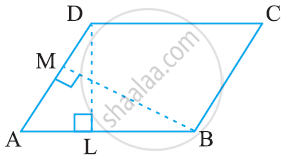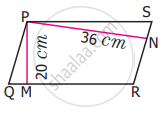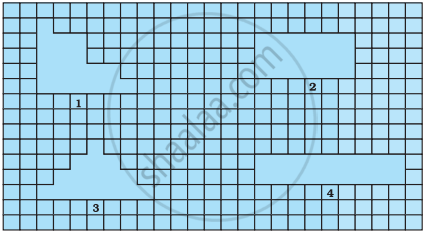Advertisements
Advertisements
प्रश्न
DL and BM are the heights on sides AB and AD respectively of parallelogram ABCD (see the given figure). If the area of the parallelogram is 1470 cm2, AB = 35 cm and AD = 49 cm, find the length of BM and DL.

उत्तर
Area of parallelogram = Base × Height
= AB × DL
1470 = 35 × DL
DL = `1470/35`
DL = 42 cm
Also, area of parallelogram = AD × BM
1470 = 49 × BM
∴ BM = `1470/49`
∴ BM = 30 cm
APPEARS IN
संबंधित प्रश्न
If area of a parallelogram is 29.6 sq cm and its base is 8 cm, find its height.
Suresh on a parallelogram-shaped trophy in a state level chess tournament. He knows that the area of the trophy is 735 sq.cm and its base is 21 cm. What is the height of that trophy?
Janaki has a piece of fabric in the shape of a parallelogram. Its height is 12 m and its base is 18 m. She cuts the fabric into four equal parallelograms by cutting the parallel sides through its mid-points. Find the area of each new parallelogram
In a parallelogram the base is three times its height. If the height is 8 cm then the area is
A square and a parallelogram have the same area. If the side of the square is 48 m and the height of the parallelogram is 18 m. Find the length of the base of the parallelogram
The height of the parallelogram is one-fourth of its base. If the area of the parallelogram is 676 sq.cm, find the height and the base
In a parallelogram PQRS (See the diagram) PM and PN are the heights corresponding to the sides QR and RS respectively. If the area of the parallelogram is 900 sq.cm and the length of PM and PN are 20 cm and 36 cm respectively, find the length of the sides QR and SR
Observe the shapes 1, 2, 3 and 4 in the figures. Which of the following statements is not correct?

If perimeter of two parallelograms are equal, then their areas are also equal.
ABCD is a parallelogram in which AE is perpendicular to CD as shown in the given figure. Also, AC = 5 cm, DE = 4 cm and area of ΔAED = 6 cm2. Find the perimeter and area of parallelogram ABCD.
